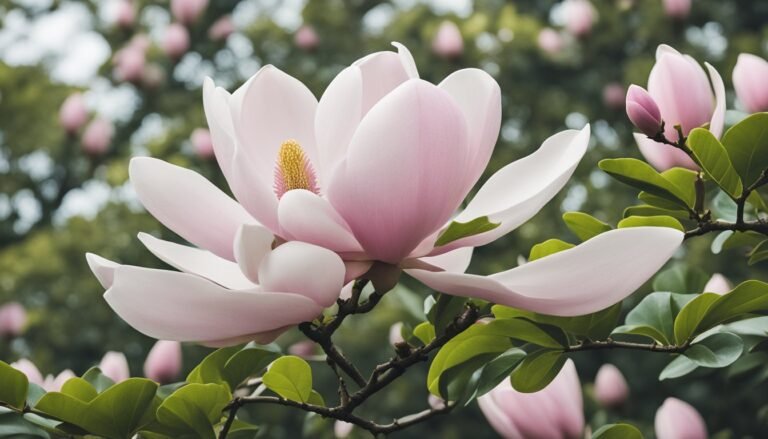Deutzia is a delightful genus of flowering plants that make a lovely addition to any garden. As a deciduous shrub, it is characterised by its hardy nature and profusion of blooms that appear predominantly in the spring and early summer. The flowers, ranging from white to pink, emerge in clusters, offering a showy display that can enhance the aesthetic appeal of garden borders and mixed shrubberies.

My experience with deutzia has taught me that they are relatively low maintenance and can thrive in a variety of garden settings. These shrubs do best with adequate sunlight but can adapt to partial shade, and they are not overly fussy about soil types, though well-draining conditions are ideal. With their attractive peeling bark, deutzia species also contribute to the winter landscape, adding textural interest when flowers are absent.
Key Takeaways
- Deutzia is a hardy, deciduous shrub with attractive blooms.
- It offers ease of care and adapts to various garden conditions.
- The shrub provides year-round interest with seasonal foliage and bark textures.
Botanical Overview
I’ll guide you through the botanical intricacies of the Deutzia genus, detailing its classification, distribution, and morphology for easy identification.
Deutzia Classification
Deutzia is a genus that belongs to the Hydrangeaceae family. With approximately 60 species, the genus is named after the 18th-century Dutch botanist, Johan van der Deutz. Key species that are popular in cultivation include Deutzia scabra and Deutzia gracilis.
Native Habitats and Distribution
The native range of Deutzia spans primarily across East Asia, with species such as Deutzia scabra originating from Japan and China. The genus also extends to Central America and Europe but is found predominantly in the Himalayas and the Philippines.
Morphology and Identification
Morphologically, Deutzia species are characterised by their deciduous nature and shrub form. My identification of these plants relies on certain features:
- Leaves: Opposite, simple with serrated margins, typically green.
- Flowers: Generally small, five-petalled, with colours ranging from white to pink.
- Habit: I’ve observed them to be bushy, with certain species like Deutzia gracilis having a more upright growth.
It’s quite evident when these plants are in bloom, from mid-spring to early summer, due to their profuse and often fragrant clusters of flowers.
Cultivation and Care
In my extensive gardening experience, deutzia has proven to be a rewarding shrub with its graceful blooms and easy-care nature. I’ll outline the essential practices for cultivation and care, ensuring your deutzia thrives in the garden.
Planting and Soil Requirements
Deutzia plants flourish in rich, moist soil that is well-drained. I’ve found the best time for planting is in the autumn, as this allows the roots to establish before the onset of winter. It’s crucial to incorporate plenty of organic matter into the planting hole and ensure the soil isn’t overly sandy or compacted. If I’m dealing with clay soils, I’ll amend it with compost to improve drainage.
Sunlight and Watering
While planting, I always choose a spot where the deutzia will receive full sun to partial shade, as too much shade can reduce blooming significantly. Regular watering is essential during the growing season, especially for new plantings. I make sure to water deeply once a week, allowing the soil to dry out slightly between watering sessions.
Pruning and Maintenance
Pruning is a vital part of maintenance, and I usually do this after the deutzia has finished flowering. By removing about a third of the oldest stems near ground level each year, I stimulate new growth and more profuse blooms. Annually, in early spring, applying a layer of mulch and a general fertilizer aids in retaining moisture and providing necessary nutrients for the plant’s growth and flowering.
Varieties and Landscaping Uses

In my experience, Deutzia offers a versatile range of varieties perfect for different landscaping applications. From delicate pink blossoms to robust hedge formations, there’s a Deutzia suitable for nearly every garden setting.
Popular Deutzia Varieties
Among the myriad of Deutzia cultivars, a few stand out for their distinctive characteristics. ‘Nikko’, for instance, is revered for its low, spreading habit, making it a superb choice for ground cover, while ‘Strawberry Fields’ boasts striking pink flowers that can enliven any garden space. Notably, the ‘Yuki Cherry Blossom’ flourishes with an array of pink panicles, and like many other hybrids, it has been cultivated for specific aesthetic qualities. On the smaller side, Deutzia gracilis manifests as a compact and graceful shrub, exhibiting an uptight growth pattern that fits well within modest spaces or containers.
Landscaping with Deutzias
When it comes to landscaping, I find that Deutzias are incredibly flexible. Dwarf varieties make for exceptional edging along borders or pathways. For larger garden areas or public spaces, I recommend using medium to larger-sized varieties for impactful foundation plantings or as part of mixed borders. The resilience and upright nature of some cultivars, like ‘Oury’, mean they are ideal for creating a living hedge. Moreover, mass planting Deutzia on slopes can aid in stemming erosion, which is a practical and beautiful solution for challenging terrains.
Container Cultivation
For gardener enthusiasts with limited space or those desiring portability, I suggest container cultivation. Smaller Deutzia varieties thrive in containers, allowing them to be a focal point on patios or balconies. It’s important to choose a container that provides adequate room for growth and to ensure proper drainage. Feeding with an appropriate fertiliser and regular watering will keep your potted Deutzias healthy and blooming.
Propagation and Common Challenges

In my gardening experience, propagating deutzia is a straightforward process but it does come with its share of potential hitches, such as specific pests and diseases to look out for.
Methods of Deutzia Propagation
Deutzia can be effectively propagated using various methods. I generally find that softwood cuttings, taken in summer or early fall, are an excellent method for propagation. These cuttings should be about 20-30 cm in length to ensure a good chance of rooting. I’d recommend using a rooting hormone and potting them into a mix of perlite and peat for the best results. An Epic Gardening guide suggests striking 8-12 inch cuttings during this time. Furthermore, hardwood cuttings are also a viable option if taken in autumn. These can be rooted directly in well-drained sandy soil.
| Method | Timing | Rooting Medium | Cutting Length |
|---|---|---|---|
| Softwood Cuttings | Summer/Early Fall | Perlite and Peat Mix | 20-30 cm |
| Hardwood Cuttings | Autumn | Well-drained Sandy Soil | 30 cm |
Pests and Diseases
Pests like aphids can be problematic when growing deutzia. They tend to feed on the undersides of leaves, potentially causing distortion and stunted growth. I tackle this issue by using a strong water spray to dislodge them or by employing natural predators like ladybirds. As for diseases, deutzias are relatively disease-resistant, but they can still be affected by fungal infections such as powdery mildew, especially in conditions that lack proper air circulation.
For managing diseases, ensuring good air circulation by spacing plants correctly and regular pruning can make a significant difference. If I see signs of disease, I act promptly, removing any affected parts and considering a fungicide if necessary.
Frequently Asked Questions

In this section, I answer common queries about the cultivation and care of Deutzia, a charming shrub that captivates with its spring blooms.
What type of soil conditions are ideal for growing Deutzia?
Deutzia plants flourish in well-draining soil, rich in organic matter. They prefer a neutral to slightly acidic pH but are adaptable to a range of soil types, provided they are kept moist but not waterlogged.
How can one mitigate common issues encountered when cultivating Deutzia?
To prevent common problems such as fungal diseases or pests, I ensure good air circulation around my Deutzia by spacing them appropriately and by doing timely pruning. It’s also vital to avoid overhead watering to prevent leaf spot diseases.
Can Deutzia thrive in containers, and if so, how should they be cared for?
Yes, Deutzia can grow well in containers. I make sure to use a well-draining potting mix and to keep the soil consistently moist. Container-grown Deutzia will need more frequent watering than those planted in the ground.
What is the best time of year to prune Deutzia, and which method is recommended?
The ideal time to prune Deutzia is shortly after they have finished flowering in the spring. I use a method called thinning, which involves removing some of the older stems at the base to encourage fresh growth and improve flowering.
Are there particular Deutzia cultivars well-suited for small gardens?
Certainly, there are compact cultivars of Deutzia like ‘Nikko’ which are ideal for small gardens due to their smaller size and low-maintenance nature. This cultivar still offers abundant flowers and attractive fall foliage.
What measures can be taken to protect Deutzia during colder seasons?
To protect my Deutzia during the winter, I apply a thick layer of mulch around the base to insulate the root system. Also, I avoid heavy pruning before the onset of cold weather as this can stimulate new growth that is susceptible to frost damage.



